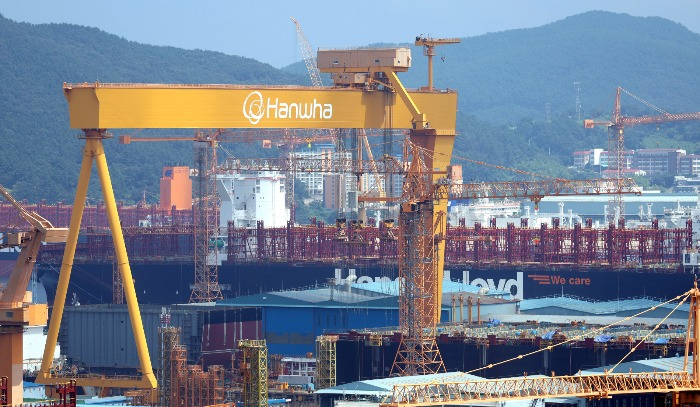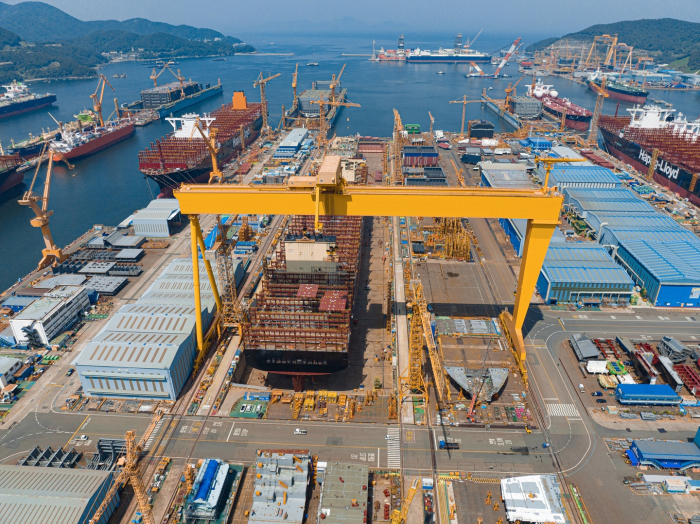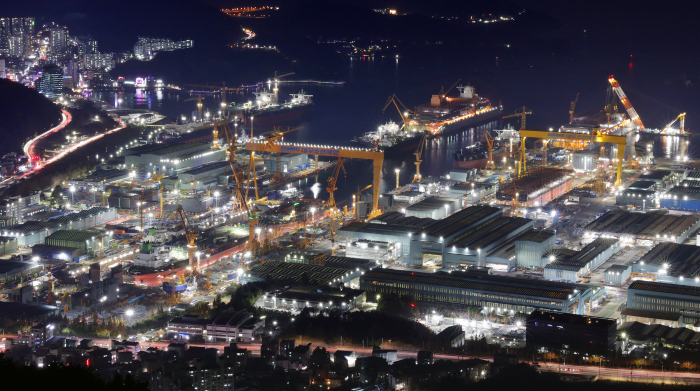Hanwha Ocean taps middle-aged women, robots for ship welding work
Four liquefied natural gas (LNG) carriers are being built simultaneously at the world's largest dock
By Oct 30, 2023 (Gmt+09:00)
LG Chem to sell water filter business to Glenwood PE for $692 million


Kyobo Life poised to buy Japan’s SBI Group-owned savings bank


KT&G eyes overseas M&A after rejecting activist fund's offer


StockX in merger talks with Naver’s online reseller Kream


Mirae Asset to be named Korea Post’s core real estate fund operator



GEOJE, Gyeongsang Province – Hanwha Ocean, the world’s No. 2 shipbuilder, is actively embracing middle-aged female workers and robots for ship welding, as it sits on a bulging order backlog for eco-friendly vessels such as liquefied natural gas (LNG) carriers.
Amid a dearth of skilled male workers at manufacturing plants nationwide, Hanwha’s new hires at its main shipyard at Geoje are increasingly including women in their 40s.
It is also deploying more robots to weld ships in narrow and confined spaces at its 4.9 million-square-meter Okpo Shipyard in Geoje, based on robot-based digitalization systems.
Some 110 welding robots each weighing 8 kilograms are working there, while four lightweight welding robots weighing 17kg are assigned to confined areas.
“This Geoje shipyard is a cradle for research, development and construction of high value-added, eco-friendly ships based on technological prowess,” said Jeong In-seop, head of Hanwha Ocean’s Geoje shipyard.
“This is a forward base that responds to the demand for eco-friendly ships and secures market leadership.”
Its Seoul office and Siheung R&D Campus, about 26 km south of Seoul, are operating a “Smart Yard Demonstration Center,” which highlights the real-time remote controls operating the Geoje shipyard.

FOUR LNG CARRIERS BEING BUILT SIMULTANEOUSLY
At the entrance of the shipyard, the first thing that caught the eyes of visitors was a 100-meter-long orange Goliath crane with the Hanwha Ocean logo.
Below the Goliath crane, as tall as a 37-story apartment building, was the first dock, buzzing with activity. The cargo loading dock, the heart of the shipyard, measures 530 meters in length and 131 meters in width.
At the first dock, four liquefied natural gas (LNG) carriers are being built simultaneously. It is the world's largest dock, 1.5 times the size of Yeouido, the large island in central Seoul.
Just a year ago, it was full of very large crude carriers (VLCCs). But this year the situation has changed completely.
As ship owners are committed to achieving carbon neutrality by 2050 in accordance with the International Maritime Organization (IMO) guidelines, Hanwha is enjoying growing demand for low-emission vessels.
Currently, 65 of its order backlog of 99 ships are LNG carriers, which emit less carbon dioxide than other types of vessels fueled by coal and oil.

There are also a raft of orders for ships with dual fuel propulsion systems. Hanwha produces VLCCs and container ships equipped with dual fuel propulsion systems.
Like hybrid vehicles, they are being fueled by coal and oil, as well as LNG stored in the vessels' LNG storage tank.
Two green LNG tanks with a storage capacity of 7,500 cubic meters were seen below from the top of a 30-meter-high ship, as tall as the 20th floor of an apartment building.
The reliquefaction device collects gas that evaporates during transportation on LNG ships and turns it back into liquid.
Hanwha Ocean was the first in the world to successfully develop the reliquefaction device, which has now been applied to more than 120 of its LNG carriers.
Write to Mi-Sun Kang at missunny@hankyung.com
Yeonhee Kim edited this article.
-
 Shipping & ShipbuildingHanwha Ocean to design digital vessels with ABS
Shipping & ShipbuildingHanwha Ocean to design digital vessels with ABSOct 30, 2023 (Gmt+09:00)
1 Min read -
 Shipping & ShipbuildingHanwha Ocean, ABS to join forces for LCO2 carrier study
Shipping & ShipbuildingHanwha Ocean, ABS to join forces for LCO2 carrier studySep 21, 2023 (Gmt+09:00)
1 Min read -
 Shipping & ShipbuildingHanwha Ocean to raise $1.5 bn to boost warship business
Shipping & ShipbuildingHanwha Ocean to raise $1.5 bn to boost warship businessAug 23, 2023 (Gmt+09:00)
3 Min read -
 Shipping & ShipbuildingHanwha Ocean succeeds in localizing key submarine acoustic equipment
Shipping & ShipbuildingHanwha Ocean succeeds in localizing key submarine acoustic equipmentJul 12, 2023 (Gmt+09:00)
1 Min read -
 Mergers & AcquisitionsDaewoo Shipbuilding enters new chapter as Hanwha Ocean
Mergers & AcquisitionsDaewoo Shipbuilding enters new chapter as Hanwha OceanMay 23, 2023 (Gmt+09:00)
2 Min read


